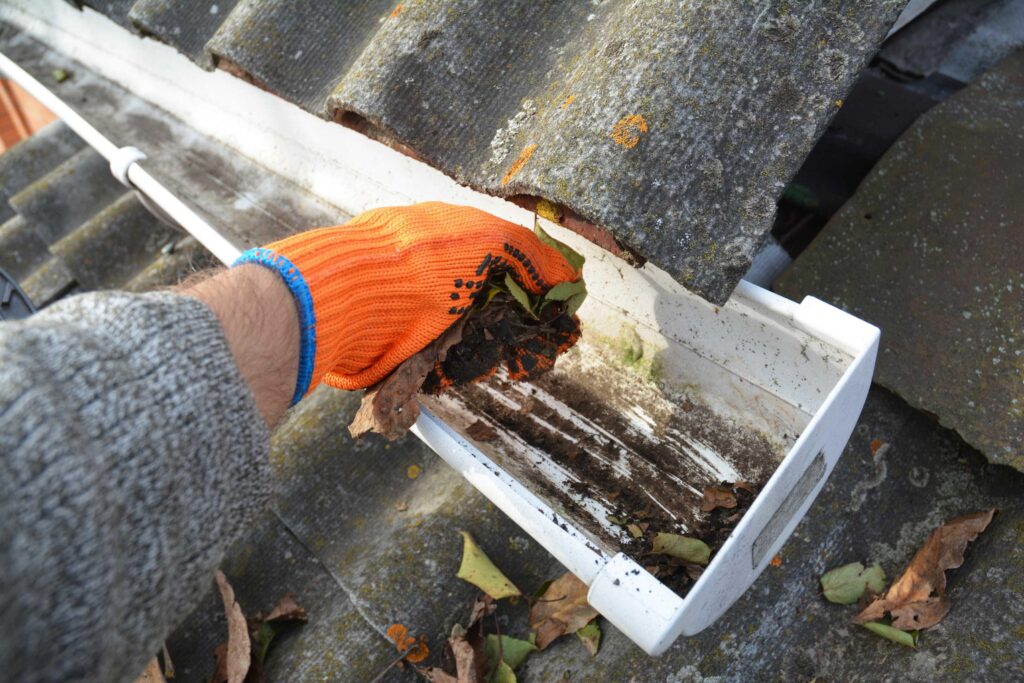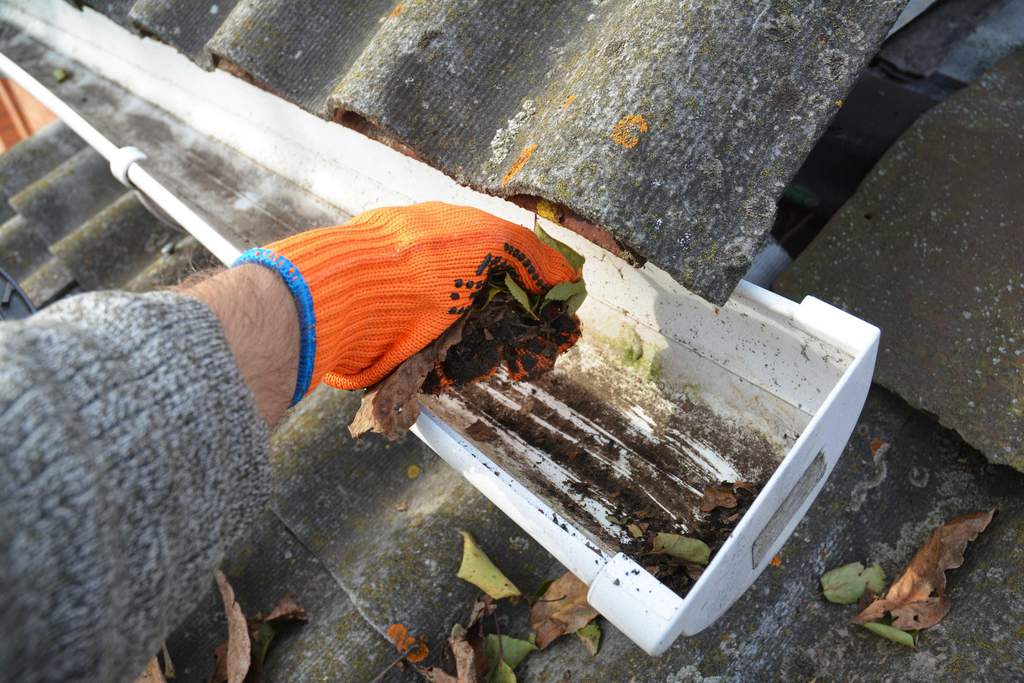
Keeping your gutters clean is one of the biggest hassles as a homeowner, but it’s absolutely necessary to prevent water damage to your home and unsightly debris on your roof. Gutter cleaning isn’t fun, but it’s important. So if you’re a new homeowner trying to learn how to take care of the investment you just made, it’s time for you to learn everything there is to know about gutter cleaning.
How do Gutters Get Dirty?
There are culprits involved in dirtying up the gutters: wind and overhang. A combination of the two is deadly for your poor gutters. Leaves, twigs, and other debris can blow around in the wind and get into your gutters. And if your house has branches hanging over the roof, you don’t even need wind for debris and even wildlife to find its way into your gutter system.
Snow and ice can also jam up your gutters. While these may not be “dirty” gutters, they present the same problems as the aforementioned debris. You still have to get up on the roof and clear it out so that your gutters can flow freely.
All kinds of things in your environment can cause dirty gutters, especially if you don’t install a proper set of gutter guards. But who cares how the gutters got dirty? Does it matter? And what do you do about it, anyway? Is gutter cleaning a job anyone can do at home?
Why Should I Clean My Gutters?
As this debris builds up, your gutters begin to get dirtier and stop serving their only purpose. Your gutters are there to protect your home, and if they aren’t keeping water away from your home, then what’s the point?
Water damage can have a significant impact on your roof and on your home as a whole. It compromises the strength of the structure and its ability to provide proper insulation. It’s also very expensive to repair, as water-damaged materials typically need to be replaced and can’t be restored. It’s important to clean your gutters on a regular basis and after any significant weather event to ensure that they’re working properly.
When you’re cleaning your gutters, you also have the opportunity to check out your gutter system as a whole to determine if it needs service. Cleaning the gutters means getting up close and personal with them, so you’ll be able to spot any damage or deterioration.
Cleaning your gutters is a part of being a homeowner just like mowing your lawn and taking out the garbage. A failure to keep up with any of these maintenance tasks can create unsanitary living conditions on your property. Protect your health and your home by cleaning your gutters when they need it and installing a gutter guard that works.
Problems with Dirty Gutters
Gutters that are jammed up with leaves and other debris block water from flowing freely to the downspout where it’s directed safely away from the home. When the downspout is fully blocked, water will simply cascade down the roof and over the side of your home onto your lawn where the excess saturation could cause damage.
The extra stress of heavy water sitting in the full gutters could also lead to the gutter system weakening and eventually collapsing entirely. This is particularly risky in high-wind environments and on aging structures.
Dirty gutters also look downright ugly. If your gutters are clogged, you can typically see debris from the street. Excess rainwater running down the side of your house can leave ugly streaks of residue signaling to all of your neighbors that you don’t take care of your home. Don’t be that guy on the block. Clean your gutters on a regular basis to maintain your home’s integrity and keep it looking its best.
How Often Should I Clean My Gutters?
Frankly, it depends. Gutter systems will get dirty at different rates depending on where they’re located even within the same neighborhood. It all comes down to how much your gutter system is exposed to falling or flying debris. And, of course, no matter where you live, there’s always the possibility of flying animals or insects to make a home in your gutter system during the dry months.
As a result, you should clean your gutters, at the very least, once per season in order to ensure they’re free of obstructions. You can find the most unexpected things blocking a gutter. Bird nests, stray tennis balls, and even sprouting plants. A regular gutter cleaning is the easiest way to ensure that these unexpected surprises don’t turn up in your gutters.
If you own a home in a more heavily forested area, you’ll have to clean your gutters more frequently. Especially during the wet season, don’t be surprised if you need a gutter cleaning twice a month or even more. In these cases, a gutter guard is absolutely essential to keeping a gutter clean without regular cleaning service. Make sure you keep an eye on your gutter so that you know how fast it jams up. If you notice debris starting to pile up, it’s time for another gutter cleaning.
DIY Gutter Cleaning vs Hiring a Gutter Cleaning Service
Hiring a guttering cleaner might sound appealing. After all, who wants to spend a Saturday afternoon cleaning gutter trash? Getting your gutter cleaned professionally is expensive, but it’s a great way to save yourself some hassle and avoid getting your hands filthy. A gutter cleaning service will also do a thorough job of getting your guttering cleaned out, and being professional gutter experts, they can spot things that you can’t.
It might be time for you to replace your gutters, but how do you know what to look for? Gutter cleaners do this job all the time, and they run cleaning services because they’re the best people for the job. Professional gutter cleaning services are a great way to make sure that the roof over your home is being protected from water damage and that the gutter cleaning job is done right.
However, if you do have to perform regular gutter cleaning, then hiring gutter cleaning services on a regular basis might be prohibitively expensive. If you want to ditch the gutter cleaning service and perform your own DIY gutter cleaning, you don’t need many tools or much expertise to get the job done at home.
How to Clean Your Gutters Yourself
Tools for the Job
For a gutter cleaning, you’re obviously going to need roof access. In the majority of this cases, this means you need a sturdy extendable ladder that you can place on a solid, level surface. Usually, it’s best that you have a spotter to help keep the ladder in place while you work.
You’ll want thick gloves since you’ll be working with nasty gutter sludge, and a scooping tool to help you clear out tougher gunk. You’ll also need a tarp and a garden hose. Finally, if you don’t have one yet, you’ll want a gutter guard system to install to keep your gutters cleaner and clearer in the future.
Safety First
When you’re working on gutters, you’re working up high on the roof. Falling from a roof can cause serious injury or death, so if your roof isn’t level, or if you don’t have experience on roofs, don’t go up on the roof at all. Instead, work from your ladder.
Additionally, always use a ladder with a buddy to support you. Even if your ladder is placed on a reliable surface, unexpected movements can cause you to lose your balance. With a spotter to catch you, you’ll be much safer as you wrestle with the debris stuck in your downspout.
Clearing the Gutters
Put on your gloves, ascend your ladder, and get to work removing the gutter debris. You might think that leaves and debris sitting around the middle of the gutter will just wash out, but this isn’t the case. This is exactly the sort of debris that causes clogs and jams in the first place. Don’t use your garden hose to try to spray this debris out. Instead, remove it by hand, moving the ladder along the side of the house as necessary until you get all of it. You’ll want to keep your tarp under you during this process to keep all of the gunk from landing haphazardly on your lawn (where your spouse definitely doesn’t want to see it).
Check all of the seams between each piece of your gutter system and remove any debris that’s stuck in it. While you’re doing so, inspect the seams and any connector pieces for rust, warping, or other signs of physical wear. Make note of this for later.
When you reach the downspout, use your hands and your trusty scooping tool to remove debris and throw it to the ground. Then, shine a light down the downspout to try and see if there’s anything jammed inside of it. If so, see if you can knock the debris loose with your garden hose.
If there’s growth in your downspout or the elbows of your gutter, climb down on your ladder to where it appears and see if you can get at it from the outside. If you can’t and you’re unable to blast it free with your garden hose, it’s probably time to call in a professional for help. Don’t attempt to use a tool like a toilet auger to reach down into it, as this can damage the inside of the gutters.
Washing the Gutters
Pick up the debris you tossed to the ground and throw it in the trash. Now the next step is to wash the gutters. Get up there and wipe down any mud and spots with a soapy sponge. You don’t have to get every little detail, but getting the bulk of the dirt off will help your gutters last longer and look better from the street.
Once you’ve wiped them down, spray them thoroughly with the hose. This is your opportunity to check that the water flows smoothly and freely all the way down the gutters and out the downspout at the bottom. Once you’re satisfied that the water is flowing and the gutters look nice, your gutter cleaning job is just about done!
Repair Any Gutter Damage
If you noted any damage to the gutters as we mentioned, the time to fix them is right now before your gutters endure any more heavy weather. Small components like wingnuts that hold gutter tubing in place are simple enough for you to repair at home. But if you notice any significant structural damage to the gutters, you’ll want to hire a service to come and take a look.
Many professional gutter cleaning service people can tell you if you’re in need of repairs, but they won’t perform repairs for you. For best results, call a local contractor that specializes in gutter installation to help you with your repairs.

